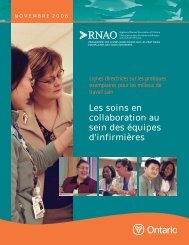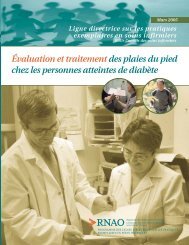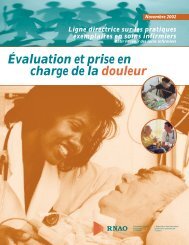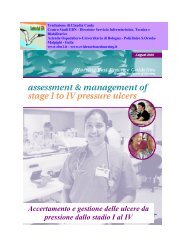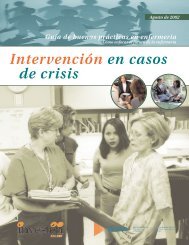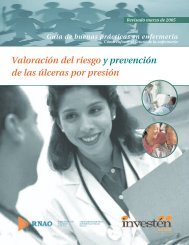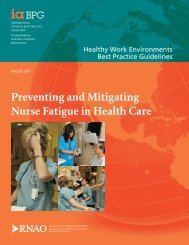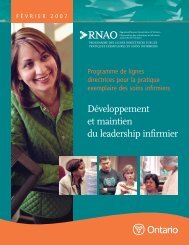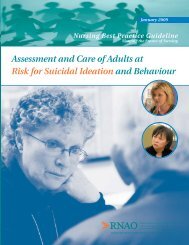Reducing Foot Complications for People with Diabetes - Registered ...
Reducing Foot Complications for People with Diabetes - Registered ...
Reducing Foot Complications for People with Diabetes - Registered ...
You also want an ePaper? Increase the reach of your titles
YUMPU automatically turns print PDFs into web optimized ePapers that Google loves.
<strong>Reducing</strong> <strong>Foot</strong> <strong>Complications</strong> <strong>for</strong> <strong>People</strong> <strong>with</strong> <strong>Diabetes</strong><br />
12<br />
RECOMMENDATION LEVEL OF EVIDENCE<br />
5.2 Education should be tailored to client’s current knowledge, IV<br />
individual needs, and risk factors. Principles of adult learning must be used.<br />
6.0 Individuals assessed as being at "higher" risk <strong>for</strong> foot ulcer/amputation IV<br />
should be advised of their risk status and referred to their primary care<br />
provider <strong>for</strong> additional assessment or to specialized diabetes or foot care<br />
treatment and education teams as appropriate.<br />
Education 7.0 Nurses need knowledge and skills in the following areas in order to IV<br />
Recommendations competently assess a client’s risk <strong>for</strong> foot ulcers and provide the required<br />
education and referral:<br />
Skills in conducting an assessment of the five risk factors;<br />
Knowledge and skill in educating clients; and<br />
Knowledge of sources of local referral.<br />
8.0 Educational institutions should incorporate the RNAO Nursing Best Practice IV<br />
Guideline <strong>Reducing</strong> <strong>Foot</strong> <strong>Complications</strong> <strong>for</strong> <strong>People</strong> <strong>with</strong> <strong>Diabetes</strong> into basic<br />
nursing education curriculum as well as provide continuing education<br />
programs in this topic area.<br />
Organization & Policy 9.0 Organizations should develop a policy that acknowledges and designates IV<br />
Recommendations human and fiscal resources to support nursing’s role in assessment,<br />
education, and referral of clients <strong>for</strong> appropriate foot care. It is the<br />
organization’s responsibility to advocate <strong>with</strong> policy makers and develop<br />
policy that facilitates implementation.<br />
10.0 Organizations should ensure that resources <strong>for</strong> implementation are IV<br />
available to clients and staff. Examples of such resources include policies<br />
and procedures, documentation <strong>for</strong>ms, educational materials, referral<br />
processes, workload hours, and monofilaments.<br />
11.0 Organizations should work <strong>with</strong> community partners to develop a process IV<br />
to facilitate client referral and access to local diabetes resources and health<br />
professionals <strong>with</strong> specialized knowledge in diabetes foot care.<br />
12.0 Organizations are encouraged to establish or identify a multidisciplinary, IV<br />
inter-agency team comprised of interested and knowledgeable persons to<br />
address and monitor quality improvement in diabetes foot<br />
complication prevention.



